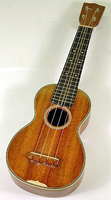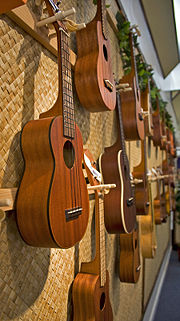Ukulele
2008/9 Schools Wikipedia Selection. Related subjects: Musical Instruments
|
The ukulele (pronounced /ˌjuːkəˈleɪli/, from Hawaiian: ʻukulele), variantly spelled ukelele (particularly in the UK), or alternately abbreviated uke, is a chordophone classified as a plucked lute; it is a subset of the guitar family of instruments, generally with four strings or four courses of strings.
The ukulele originated in the 19th century as a Hawaiian interpretation of small Portuguese guitar called cavaquinho (not to be confused with the so called Portuguese guitar). It gained great popularity elsewhere in the United States during the early 20th century, and from there spread internationally.
Tone and volume of the instrument vary with size and construction. Ukuleles come in four sizes, Soprano, Concert, Tenor, and Baritone.
History
Hawaii
The ukulele is commonly associated with music from Hawaii, where the name roughly translates as "jumping flea". According to Queen Lili'uokalani, the last Hawaiian monarch, the name means “the gift that came here”, from the Hawaiian words “uku” (gift or reward) and “lele” (to come).
Developed in the 1880s, the ukulele is based on a small guitar-like instrument, the cavaquinho, introduced to the Hawaiian Islands by Portuguese immigrants. Three immigrants in particular, Madeiran cabinet makers Manuel Nunes, José do Espírito Santo, and Augusto Dias, are generally credited as the first ukulele makers. Two weeks after they landed aboard the Ravenscrag in late August 1879, the Hawaiian Gazette reported that "Madeira Islanders recently arrived here, have been delighting the people with nightly street concerts."
One of the most important factors in establishing the ukulele in Hawaiian music and culture, was the ardent support and promotion of the instrument by King David Kalakaua. A patron of the arts, he incorporated it into performances at royal gatherings.
U.S. mainland
The ukulele was popularized for a stateside audience during the Panama Pacific International Exposition, held for most of 1915 in San Francisco. The Hawaiian Pavilion featured a guitar and ukulele ensemble, George E. K. Awai and his Royal Hawaiian Quartette, along with ukulele maker and player Jonah Kumalae. The popularity of the ensemble with visitors launched a fad for Hawaiian-themed songs among Tin Pan Alley songwriters. The ensemble also introduced both the lap steel guitar and the ukulele into U.S. mainland popular music, where it was taken up by vaudeville performers such as Roy Smeck and Cliff "Ukulele Ike" Edwards.
The ukulele soon became an icon of the Jazz Age. Highly portable and relatively inexpensive, it also proved popular with amateur players throughout the 1920s, as is evidenced by the introduction of uke chord tablature into the published sheet music for popular songs of the time, a role that would eventually be supplanted by the guitar in the early years of rock and roll. A number of mainland-based instrument manufacturers, among them Regal, Harmony, and Martin, added ukulele, banjolele, and tiple lines to their production to take advantage of the demand.
From the late 1940s to the late 1960s, plastics manufacturer Mario Maccaferri turned out about 9 million toy ukuleles. Much of the instrument's popularity was cultivated via "The Arthur Godfrey Show" on television.
World
- Japan: The ukulele came to Japan in 1929 after Hawaiian-born Yukihiko Haida returned to the country upon his father's death and introduced the instrument. Haida and his brother Katsuhiko formed the Moana Glee Club, enjoying rapid success in an environment of growing enthusiasm for Western popular music, particularly Hawaiian music and jazz. During World War II, authorities banned most Western music, but fans and players kept it alive in secret, and it resumed popularity after the war. In 1959, Haida founded the Nihon Ukulele Association. Today, Japan is considered a second home for Hawaiian musicians and ukulele virtuosos.
- Canada: In the 1960s, educator J. Chalmers Doane dramatically changed school music programs across Canada, using the ukulele as an inexpensive and practical teaching instrument to foster musical literacy in the classroom. There were 50,000 schoolchildren and adults learning ukulele through the Doane program at its peak.
Pronunciation
While the mainstream American English pronunciation of "ukulele" is /ˌjuːkəˈleɪli/, some English speakers prefer to accurately follow the original Hawaiian pronunciation: /ˌuːkuˈlele/. Though the American English pronunciation is more common overall, the Hawaiian pronunciation is favored within Hawaii and by individuals interested in Hawaiian culture.
Types and tunings
Construction
Ukuleles are generally made of wood, although variants have been made composed partially or entirely of plastic. Cheaper ukuleles are generally made from ply or laminate woods, in some cases with a soundboard of an inexpensive but acoustically superior wood such as spruce. Other more expensive ukuleles are made of exotic hardwoods such as mahogany. Some of the most valuable ukuleles, which may cost thousands of dollars, are made from koa, a Hawaiian wood known for its fine tone and attractive colour and figure. photo
Typically ukuleles have a figure-eight body shape similar to that of a small acoustic guitar. They are also often seen in non-standard shapes, such as an oval, usually called a "pineapple" ukulele, or a boat-paddle shape, made popular by the Fluke brand of ukulele, and occasionally a square shape, often made out of an old wooden cigar box.
These instruments may have just four strings; or some strings may be paired in courses, giving the instrument a total of six or eight strings.
Sizes
There are four sizes of ukuleles, Soprano (21 inches), Concert (23 inches), Tenor (26 inches), and Baritone (30 inches). There are also sopranino and bass ukuleles at the extreme ends of the size spectrum.
The Soprano, often called "standard" in Hawaii, is the smallest, and the original size ukulele. The Concert size was developed in the 1920s as an enhanced Soprano, slightly larger and louder with a deeper tone. Shortly thereafter, the much larger Tenor was created, having more volume and deeper bass tone. The largest size is the Baritone, created in the 1940s, it is considered a miniature 4-string guitar.
| Type | Scale length | Total length | Tuning |
|---|---|---|---|
| soprano or standard (the original size) | 13" (33 cm) | 21" (53 cm) | g-C-E-A |
| concert | 15" (38 cm) | 23" (58 cm) | g-C-E-A |
| tenor (created in the 1920s) | 17" (43 cm) | 26" (66 cm) | g-C-E-A |
| baritone (created in the late 1940s) | 19" (48 cm) | 30" (76 cm) | D-G-B-E |
Tuning
The standard tuning for soprano, concert, and tenor ukuleles is C-tuning, g-C-E-A. The g string is tuned an octave higher. This is known as re-entrant tuning. Some prefer "Low G" tuning, with the G an octave lower. The baritone is usually tuned to D-G-B-E (low to high), matching the tuning of the top four strings of a guitar.
Another common tuning (also the more 'traditional' tuning) for sopranos and concerts is D-tuning, A-D-F#-B, one step higher than the g-C-E-A tuning. This is said by some to bring out a sweeter tone in some ukuleles, generally smaller ones.
Hawaiian ukuleles may also be tuned to open tunings, similar to the Hawaiian slack key style. These tunings would include "wahine" tunings.
Related instruments
Ukulele varieties include hybrid instruments such as the banjo ukulele, harp ukulele, and lap steel ukulele. There is an electrically amplified version, the electric ukulele. The resonator ukulele is louder and of different tone quality than traditional wooden ukuleles, producing sound by one or more spun aluminium cones ( resonators) instead of the wooden soundboard. Another unique variant is the Tahitian ukulele which is usually carved from a single piece of wood and does not have a hollow soundbox.
Close cousins of the ukulele include the Portuguese forerunners, the cavaquinho (also commonly known as machete or braguinha) and the slightly larger rajão. Other stringed variants include the Puerto Rican bordonua, the Venezuelan cuatro, the Colombian tiple, the timple of the Canary Islands, the Spanish vihuela, and the Bolivian charango traditionally made of an armadillo shell. In Indonesia, a similar Portuguese-inspired instrument is the kroncong.

